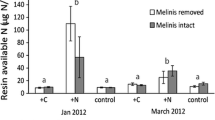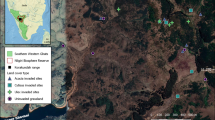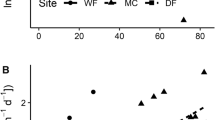Abstract
Increased nitrogen availability is known to favor invasion by non-native plants into natural grasslands. This suggests that decreasing nitrogen availability might serve as a countermeasure against invasion. One way to at least temporarily decrease nitrogen availability to plants is to increase microbial nitrogen uptake by adding carbon to the soil, and sawdust is a carbon source whose low cost could make it a practical conservation tool. To test whether adding sawdust to soil can counter the tendency of nitrogen enrichment to promote invasions by non-native plants, we hand-tilled 1.5 kg sawdust/m2 into the upper soil of the bare, nitrogen-rich patches left by dead shrubs of the nitrogen-fixing shrub Lupinus arboreus in two nearby areas with contrasting levels of invasion in a coastal grassland in northern California. After two years, in both areas, patches with sawdust had 40% less biomass of non-native plants than patches without sawdust, whereas biomass of native plants was not affected by sawdust addition. The more negative effect of sawdust on non-native species was specifically due to an effect on non-native grasses; adding sawdust increased the frequency of both native and non-native forbs. Results suggest that adding carbon as sawdust to soil can help counter invasion of grassland by non-native plants when invasion is being promoted by increased nitrogen availability, especially when the major invasive species are grasses.
Similar content being viewed by others
References
Alpert P, Bone E and Holzapfel C (2000) Invasiveness, invasibility, and the role of environmental stress in preventing the spread of non-native plants. Perspectives in Plant Ecology, Evolution and Systematics (in press)
Barbour MG, Craig RB, Drysdale FR and Ghiselin MT (1973) Coastal Ecology: Bodega Head. University of California Press, Berkeley, California
Bobbink R (1991) Effects of nutrient enrichment in Dutch chalk grassland. Journal of Applied Ecology 28: 28-41
Burke MJW and Grime JP (1996) An experimental study on plant community invasibility. Ecology 77: 776-796
Davidson ED (1975) Demography of Lupinus arboreus at Bodega Head, California. Ph.D. Dissertation, University of California, Davis
Hickman JC (ed) (1993) The Jepson Manual, Higher Plants of California. University of California Press, Berkeley, California
Huenneke LF, Hamburg SP, Koide R, Mooney HA and Vitousek PM (1990) Effects of soil resources on plant invasion and community structure in Californian serpentine grassland. Ecology 71: 478-491
Jonasson S, Michelsen A, Schmidt IK, Nielsen EV and Callaghan TV (1996) Microbial biomass C, N, and P in two arctic soils and responses to addition of NPK fertilizer and sugar: implications for plant nutrient uptake. Oecologia 106: 507-515
Kolb A (1999) Patterns of biological invasion in a California coastal grassland — the role of environmental stress. MSc Thesis, University of Massachusetts, Amherst
Maron JL (1998) Insect herbivory above-and below-ground: individual and joint effects on plant fitness. Ecology 79: 1281-1293
Maron JL and Connors PG (1996) A native nitrogen-fixing shrub facilitates weed invasion. Oecologia 105: 302-312
Maron JL and Jefferies RL (1999) Bush lupine mortality, altered resource availability and alternative vegetation states. Ecology 80: 443-454
Marrs RH (1993) Soil fertility and nature conservation in Europe: theoretical considerations and practical management solutions. Advances in Ecological Research 24: 242-300
McLendon T and Redente E (1992) Effects of nitrogen limitation on species replacement dynamics during early succession on a semiarid sagebrush site. Oecologia 91: 312-317
Milchunas DG and Lauenroth WK (1995) Inertia in plant community structure: state changes after cessation of nutrient-enrichment stress. Ecological Applications 5: 452-458
Morgan JP (1994) Soil impoverishment — a little-known technique holds potential for establishing prairie. Restoration & Management Notes 12: 55-56
Morghan KJR and Seastedt TR (1999) Effects of soil nitrogen reduction on non-native plants in restored grasslands. Restoration Ecology 7: 51-55
Reynolds HL (1999) Plant interactions: competition. In: Pugnaire FI and Valiadares F (eds) Handbook of Funetional Plant Ecology, pp 649-676. Marcel Dekker, New York
Schimel JP, Jackson LE and Firestone MK (1989) Spatial and temporal effects on plant-microbial competition for inorganic nitrogen in a California annual grassland. Soil Biology and Biochemistry 21: 1059-1066
Schmidt IK, Michelsen A and Jonasson S (1997) Effects on plant production after addition of labile carbon to arctic/alpine soils. Oecologia 112: 305-313
Seastedt TR, Duffy PA, and Knight JN (1996) Reverse fertilization experiment produces mixed results (Colorado). Restoration & Management Notes 14: 164
Shaver GR and Chapin FS III (1980) Response to fertilization by various plant growth forms in an Alaskan tundra: nutrient accumulation and growth. Ecology 61: 662-675
SPSS (1997) Systat 7.0, SPSS, Inc., Chicago, Illinois
Stock WD, Wienand KT and Baker AC (1995) Impacts of invading N2-fixing Acacia species on patterns of nutrient cycling in two Cape ecosystems: evidence from soil incubation studies and 15N natural abundance values. Oecologia 101: 375-382
Strong DR, Maron JL, Connors PG, Whipple AV, Harrison S and Jefferies RL (1995) High mortality, fluctuation in numbers, and heavy subterranean insect herbivory in bush lupine, Lupinus arboreus. Oecologia 104: 85-92
TIC (1973) Nitrite and nitrate in water and wastewater. Industrial method 100-70W. Technicon Instrument Corporation, Tarrytown, New York
Vitousek PM and Walker LR (1989) Biological invasion by Myrica faya in Hawaii: plant demography, nitrogen fixation, ecosystem effects. Ecological Monographs 59: 247-265
Vitousek PM, Aber JD, Howarth RW, Likens GE, Matson PA, Schindler DW, Schlesinger WH and Tilman DG (1997) Human alterations of the global nitrogen cycle: sources and consequences. Ecological Applications 7: 737-750
Wedin DA and Tilman D (1996) Influence of nitrogen loading and species composition on the carbon balance of grasslands. Science 274: 1720-1723
Wilson SD and Gerry AK (1995) Strategies for mixed-grass prairie restoration: herbicide, tilling, and nitrogen manipulation. Restoration Ecology 3: 290-298
Yarie J and Van Cleve K (1996) Effects of carbon, fertilizer, and drought on foliar chemistry of tree species in interior Alaska. Ecological Applications 6: 815-827
Young JA, Clements CD and Blank RR (1997) Influence of nitrogen on antelope bitterbrush seedling establishment. Journal of Range Management 50: 538-540
Young JA, Trent JD, Blank RR and Palmquist DE (1998) Nitrogen interactions with medusahead (Taeniatherum caput-medusae ssp. asperum) seedbanks. Weed Science 46: 191-195
Rights and permissions
About this article
Cite this article
Alpert, P., Maron, J.L. Carbon Addition as a Countermeasure Against Biological Invasion by Plants. Biological Invasions 2, 33–40 (2000). https://doi.org/10.1023/A:1010063611473
Issue Date:
DOI: https://doi.org/10.1023/A:1010063611473




